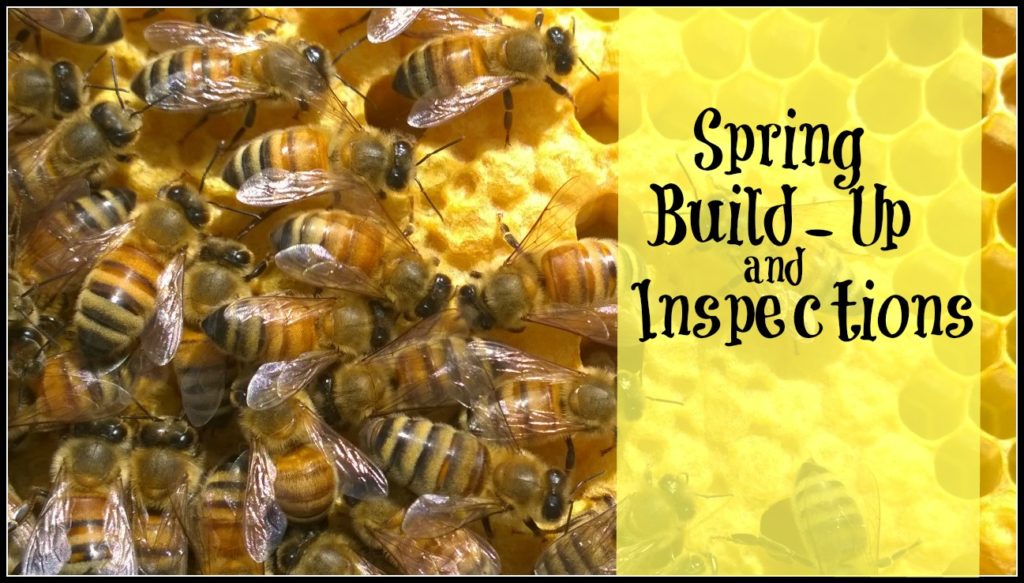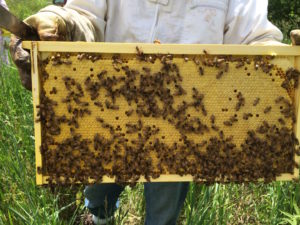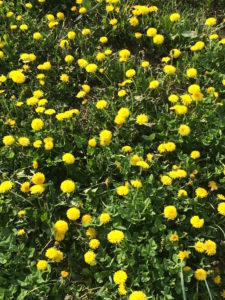Bee season has started, but I’m not working hives. Instead, I’m in Oregon ever-so-attentively managing a single bee: our ba-bee grandson. His parents returned to work in April, and Grandpy and I have been here since. We’re totally enthralled with little Thomas. I don’t know how we’ll ever leave him shortly, but thank goodness for bees at home whom we suspect need some attention. (Special thanks to our beek friends checking them for us.)
Easier Package Installation
I’ve done hundreds of package installs over the years, and wished I’d known about this less-stress, better-for-bees method years ago. Dr. Larry Connor recommended it to me; I now teach it in my bee-ginner classes and have used it very successfully.
Someone from one of my classes found a lovely video of this method (put box in vs shaking). While a bit long, it makes a very compelling case for the gentler method. Find it at: https://www.youtube.com/watch?v=T9qu-zMhtQ0
I’ve also included a few reminder pictures for handling the queen …Continue Reading
Booming Bees?
There is SO much happening in hives this time of year. Colonies are expanding, and the weather has allowed for massive nectar (soon to be honey?) collection. We’ve been busy mentoring newbees, and taking calls and answering texts about similar issues.
Hopefully your colony is booming. Here are some amazing statistics to consider. According to Dr. Larry Connor, who spoke at to Kalamazoo Bee Club last week, a full deep frame of bees yields 5,000 – 6,000 bees. A vibrant queen in a thriving hive will lay a frame every 2-3 days. The package you installed contained only about 10,000–so as that queen reaches her peak laying, the hive’s growth is exponential (and awesome!) It is a fun time of year with colonies expanding so rapidly. It means swarms, lots of nectar gathering, queen cells, and splits to be made to increase the number of hives. (We had some mentees with such powerful nucs that yes, we’ve already split them. They doubled their number of hives their first two months of beekeeping.)
Spring Build-Up and Inspections

Wednesday night Anne Marie Fauvel, beekeeper and educator from Grand Valley State University, spoke to the bee club about spring her spring to-do list. Below is an overview of the information covered.
This time of year new beekeepers are always anxious to get into their hives, but aren’t entirely sure what they should be doing or looking for. Anne’s presentation covered two important components for this time of year: why a spring build-up in important and what to look for during spring hive inspections.Continue Reading
New Colony Insights
A national beekeeping survey just released results of last year’s losses – a jaw-dropping 44%. That’s not sustainable.
Lots of people are trying to help our critical pollinators, thank goodness. But the beekeeping learning curve is steep.
Early Spring Activities; Let ’em Grow!
The over 1,000 bulbs we’ve planted in the yard are providing much-needed nutrition for growing honey bee colonies. We find them beautiful, but we won’t be mowing for a bit … sorry neighbors! But if we could all not mow for a bit, that would let dandelions–a key nutrition source for pollinators–flourish. Please? It’ll be better for the planet …
We’re getting calls about spring issues. I’ve recently posted a blog on my site that covers some of the common questions, you can check it out here. It covers things like cleaning up a dead-out, spring feeding (please don’t mow dandelions) and installation.
A Beekeeper’s Spring To-Do List
When should I uncover my hives?
More and more beekeepers in the north are experimenting with different overwintering protections: insulation, foam, wind blocks, heating elements, etc. As the weather begins to warm up, beekeepers begin to wonder when they should take this winter protection down.Continue Reading
Let’s All Try to Bee There
I have a girlfriend who fosters cats. It’s lots of work, but she loves it and has learned a lot.
The biggest thing she’s learned over the years? Her limits. She says six felines are all she can handle and love without going crazy.
I asked her how many she had at that time.
“Eleven,” she replied sheepishly.
Thinking about her answer still makes me laugh.Continue Reading
Are Your Nucs Normal?
I recently joined an online group for SE Beekeepers. (They were kind enough to let me join, despite my “west side” zip code). I’ve noticed a trend these last few weeks in comments from new beekeepers. They take different forms, but post after post I see, “Is this normal?” So whether you installed a nuc or a package this spring, here are some questions other newbies are asking:
- “I couldn’t wait 9 days and I opened the hive after 5, is this ok?”
- “Is it normal for queens to die in the first week?”
- “Is it normal for nucs/packages to swarm right away?”
- “My bees have only filled 3-4 frames, is this normal?”
- “Is it normal to see evidence of supersedure already?“
Before Bees Have Their Coffee …
Dronings from a Queen Bee: Before Bees Have Their Coffee …
I’ve been keeping bees since 2008, and the overwhelming majority of the time, the bees I’ve been keeping are content and many times, practically welcoming.
The few times they haven’t been, there’s usually been a good reason—inclement weather, I’m robbing their honey, there is no queen bee (the most important bee in the colony), or they have a queen bee under incubation. Bees’ bee-havior—when conditions are appropriate—is usually so nonchalant that I even tell my bee-ginner beekeeping classes that they probably won’t need a smoker until later in the season.
I’m wrong. So very, very, wrong.





